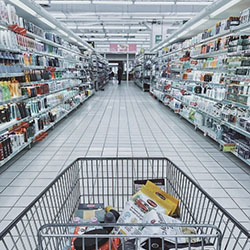Every Little Helps: The rise of the Data Supermarket
Gartner recently declared that “the data centre is dead”. But what do they mean by data centre? Terms like hyperscale, enterprise, CoLo, edge, micro, server room, HPC and cloud have rendered the term almost redundant. As the industry has grown it has fragmented and mutated, resulting in a multitude of terms now used to describe the physical locations data is stored. Gartner’s use of the term “data centre” actually refers to the traditional on-premise server rooms that organisations used to rely on for storing the data they needed to function. As companies search for more scalable, flexible and manageable data solutions, they are turning in droves to the cloud. CoLo providers are the big winners from this seismic shift and are swooping in, willing and eager to hoover up the megabytes on offer.
Colocation providers are using economies of scale to become “supermarkets” of data. They are deploying large scale facilities at scale offering everything under one roof at a cost effective price point. Supermarkets have grown to dominate the grocery market due to their convenience and price, gained through buyer power and scalability. Similarly, the colocation market is beginning to consolidate around several mega players who can use their leverage to buy land, secure grid connections, do international deals for critical infrastructure and sell white space off-plan. This business model relies on scale and efficiency and for supply chain partners, the reward of long term contracts has to be earned through the ability to match the ambitions of their customers. As with supermarkets, potential suppliers to the new breed of CoLos must be able to accommodate large production volumes, be flexible in order to cope with changing demand and show engineering ingenuity in order to deliver solutions that push the envelope of what has gone before.


Take cooling as an example. The cooling of servers represents around 40-50% of the energy consumed by a data centre. Therefore it is no surprise that these super-colos are laser-focussed on how to achieve maximum efficiencies in their cooling solutions. Making best use of real estate is a key driver for CoLo providers and therefore, as with the shelves in a supermarket, any floorspace not taken up by servers costs the provider money. This means maximising server density and maximising the efficiency of indoor CRAC units or removing them altogether by utilising fan walls in adjacent plant rooms.
As with supermarkets, the global CoLo market is beginning to be dominated by a small number of huge players. They compete on price and availability as they know consumers have a choice and are unlikely to be loyal to one provider. This means that marginal gains are important in order to gain an edge. With cooling representing such a large percentage of data centre running costs, manufacturers are under pressure to innovate.
Optimisation of indoor precision cooling equipment (CRACs) involves putting as many kW of cooling into the smallest footprint possible. Deep chilled water coils, close approach temperatures, optimised air flows, reduced air-side pressure drops all make this possible. Further efficiencies can be gained through optimisation of set point, water and air temperatures in order to maximise free cooling and to avoid over-cooling the space. A combination of intelligent system design, matched free cooling chillers and smart HVAC optimisation software can be used to achieve this.
Fan walls have come to prominence in data centres in recent years with many developers selecting them due to the removal of a need for a raised floor. Fan walls work particularly well in data centres with hot aisle containment; the pressure differential between the hot and cold aisles does the bulk of the work, with the fan wall able to operate at a low fan speed. Air is returned to the fan wall via a common plenum in the ceiling creating a constant recirculation of air and avoiding the mixing of hot and cold air streams. Fan walls designed for their environment and considered as part of an intelligent system can bridge the gap between air handling unit and precision cooling. Cooling systems utilising fan walls can be designed to operate with optimised air and water side conditions, thus maximising free cooling and operating efficiencies.
What is encouraging from a manufacturer’s perspective is that CoLo providers are more than willing to engage directly with them in order to facilitate this kind of innovation. They are willing to invest in technology that will give them an edge and aren’t obsessed with up front capital cost, preferring instead to take a holistic view of CAPEX and OPEX. This is a refreshing change from other sectors where contractors hold the power and will dilute specifications in order to screw down prices. The perfect storm of a market in growth, healthy competition and a desire to improve is driving the industry to new levels which we can all benefit from.
As with supermarkets, it seems like super-colocation is here to stay. The data centre isn’t dead, people are just shopping in different places.
– Darren Farrar, Marketing Manager, Airedale International







